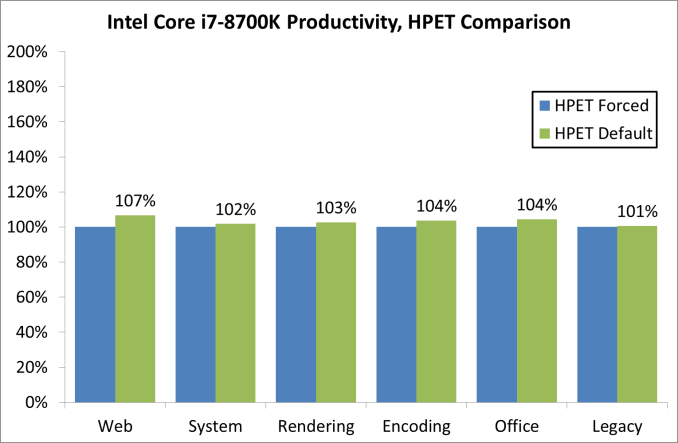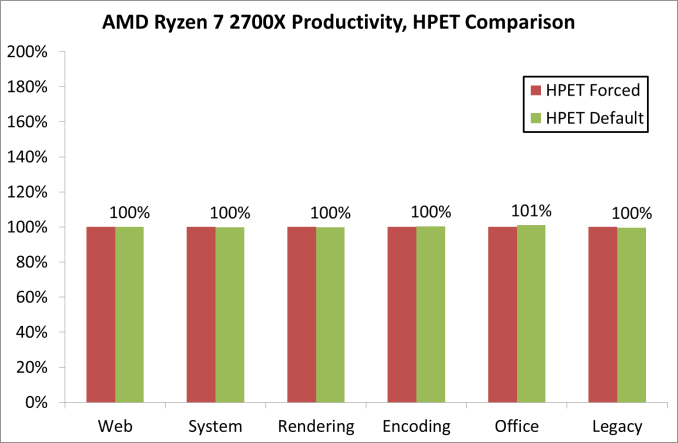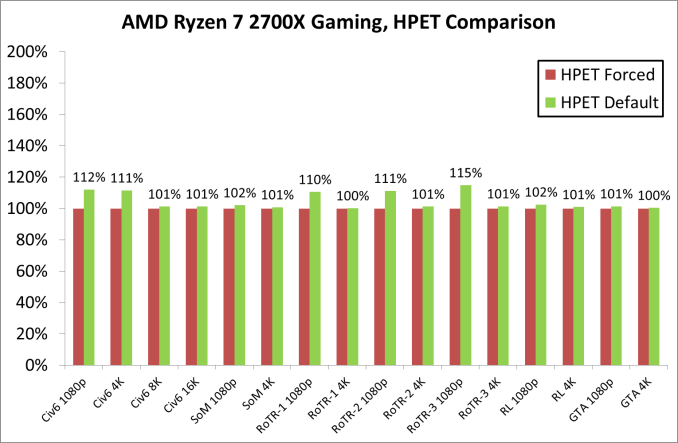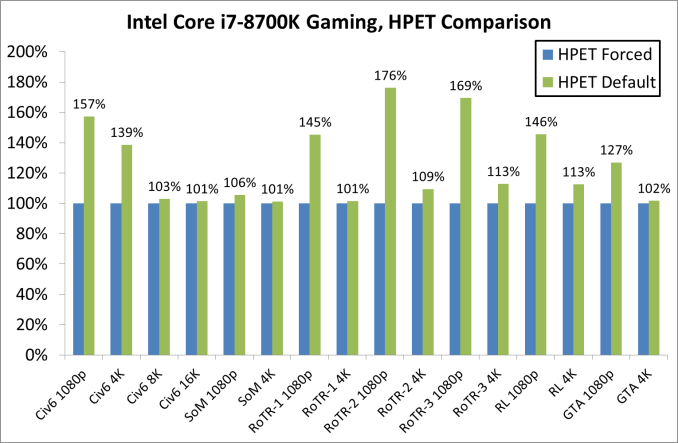A Timely Discovery: Examining Our AMD 2nd Gen Ryzen Results
by Ian Cutress & Ryan Smith on April 25, 2018 11:15 AM ESTForcing HPET On, Plus Spectre and Meltdown Patches
Based on my extreme overclocking roots back in the day, my automated benchmark scripts for the past year or so have forced HPET through the OS. Given that AMD’s guidance is now that it doesn’t matter for performance, and Intel hasn’t even mentioned the issue relating to a CPU review, having HPET enabled was the immediate way to ensure that every benchmark result was consistent, and would not be interfered with by clock drift on special motherboard manufacturer in-OS tweaks. This was a fundamental part of my overclocking roots – if I want to test a CPU, I want to make certainly sure that the motherboard is not causing any issues. It really gets up my nose when after a series of CPU testing, it turns out that the motherboard had an issue – keeping HPET on was designed to stop any timing issues should they arise.
From our results over that time, if HPET was having any effect, it was unnoticed: our results were broadly similar to others, and each of the products fell in line with where they were expected. Over the several review cycles we had, there were a couple of issues that cropped up that we couldn’t explain, such as our Skylake-X gaming numbers that were low, or the first batch of Ryzen gaming tests, where the data was thrown out for being obviously wrong however we never managed to narrow down the issue.
Enter our Ryzen 2000 series numbers in the review last week, and what had changed was the order of results. The way that forcing HPET was affecting results was seemingly adjusted when we bundle in the Spectre and Meltdown patches that also come with their own performance decrease on some systems. Pulling one set of results down further than expected started some alarm bells and needed closer examination.
HPET, by the way it is invoked, is programmed by a memory mapped IO window through the ACPI into the circuit found on the chipset. Accessing it is very much an IO command, and one of the types of commands that fall under the realm of those affected by the Spectre and Meltdown patches. This would imply that any software that required HPET access (or all timing software if HPET is forced) would have the performance reduced even further when these patches are applied, further compounding the issue.
It Affects AMD and Intel Differently: Productivity
So far we have done some quick initial re-testing on the two key processors in this debate, the Ryzen 7 2700X and Intel Core i7-8700K. These are the two most talked about processors at this time, due to the fact that they are closely matched in performance and price, with each one having benefits in certain areas over the other. For our new tests, we have enabled the Spectre/Meltdown patches on both systems – HPET is ‘on’ in the BIOS, but left as ‘default’ in the operating system.
For our productivity tests, on the Intel system, there was an overall +3.3% gain when un-forcing HPET in the OS:
The biggest gains here were in the web tests, a couple of the renderers, WinRAR (memory bound), and PCMark 10. Everything else was pretty much identical. Our compile tests gave us three very odd consecutive numbers, so we are looking at those results separately.
On the AMD system, the productivity tests difference was an overall +0.3% gain when un-forcing HPET in the OS:
This is a lower gain, with the biggest rise coming from PCMark10’s video conference test to the tune of +16%. The compile test results were identical, and a lot of tests were with 1-2%.
If Affects AMD and Intel Differently: Gaming
The bigger changes happen with the gaming results, which is the reason why we embarked on this audit to decipher our initial results. Games rely on timers to ensure data and pacing and tick rates are all sufficient for frames to be delivered in the correct manner – the balance here is between waiting on timers to make sure everything is correct, or merely processing the data and hoping it comes out in more or less the right order: having too fine a control might cause performance delays. In fact, this is what we observe.
With our GTX 1080 and AMD’s Ryzen 7 2700X, we saw minor gains across the board, however it was clear that 1080p was the main beneficiary over 4K. The 10%+ adjustments came in only Civilization 6 and Rise of the Tomb Raider.
Including the 99th percentile data, removing HPET gave an overall boost of around 4%, however the most gains were limited to specific titles at the smaller resolutions, which would be important for any user relying on fast frame rates at lower resolutions.
The Intel side of the equation is where it gets particularly messy. We rechecked these results several times, but the data was quite clear.
As with the AMD results, the biggest beneficiaries of disabling HPET were the 1080p tests. Civilization 6 and Rise of the Tomb Raider had substantial performance boosts (also in 4K testing), with Grand Theft Auto observing an additional +27%. By comparison, Shadow of Morder was ‘only’ +6%.
Given that the difference between the two sets of data is related to the timer, one could postulate that the more granular the timer, the more the effect it can have: on both of our systems, the QPC timer is set for 3.61 MHz as a baseline, but the HPET frequencies are quite different. The AMD system has a HPET timer at 14.32 MHz (~4x), while the Intel system has a HPET timer at 24.00 MHz (~6.6x). It is clear that the higher granularity of the Intel timer is causing substantially more pipeline delays – moving from a tick-to-tick delay of 277 nanoseconds to 70 nanoseconds to 41.7 nanoseconds is crossing the boundary from being slower than a CPU-to-DRAM access to almost encroaching on a CPU-to-L3 cache access, which could be one of the reasons for the results we are seeing, along with the nature of how the HPET timer works.
There is also another aspect to gaming that does not appear with standard CPU tests: depending on how the engine is programmed, some game developers like to keep track of a lot of the functions in flight in order to either adjust features on the fly, or for internal metrics. For anyone that has worked extensively on a debug mode and had to churn through the output, it is basically this. If a title had shipped with a number of those internal metrics still running in the background, this is exactly the sort of issue that having HPET enabled could stumble upon - if there is a timing mismatch (based on the way HPET works) and delays are introduced due to these mismatches, it could easily slow down the system and reduce the frame rate.














242 Comments
View All Comments
eva02langley - Thursday, April 26, 2018 - link
They didn't got it wrong, they simply used default setting for default systems. Even Intel told them to leave HPET on.eddman - Thursday, April 26, 2018 - link
No, Ian was forcing HPET to be used in the benches. He didn't use the default state. Intel did not tell them to FORCE HPET to be used either.peevee - Thursday, April 26, 2018 - link
They did got it wrong. 100% their fault, with the stupid excuse that their background is in overclocking.rocky12345 - Wednesday, April 25, 2018 - link
Good to see things cleared up on this. My question is this I under stand that on the AMD's systems turn HPET to forced on from Ryzen Master needing it am I right on that. So that explains why it was turned on for the AMD systems but if it was not at default for the Intel systems as well how or what changed it to forced on the Intel systems? Was it changed in the Intel bios to enabled which then forced the OS to use the forced on option. My other concern is that if it eats away at so much performance why havn't Intel and AMD come up with better ways to deal with this issue or is it kinda like a newer problem because of Spectre/Meltdown patches and micro code updates on the Intel platform and HPET in forced mode kills performance because of that.johnsmith222 - Wednesday, April 25, 2018 - link
They've forced HPET on in benchmarks via script (as I understand from article) and for AMD it is irrelevant be it on or off (also explained in the article).rocky12345 - Wednesday, April 25, 2018 - link
So basically the moral of the story here is leave things as the hardware vendor intended or in default settings and everything should be fine. This does raise about a million more questions on how reviewers should or even need to change the way they setup the gear for reviewing etc etc. It also confirms well this and probably a lot of other variables in the hardware that can skew results one way or another it answers the question or at least part of it as to why the same hardware performs so differently from review to review. Just for the record I am not saying Anandtech in any way tried to skew the numbers in anyway I am very sure that is not the case here.Maxiking - Wednesday, April 25, 2018 - link
Well, if you have been enforcing HPET on for all those years, it pretty much means that all the tests on this site are not valid and not representative at all.HPET is widly known as the reason causing several perfomance issues /stuttering, fps drops on cpus with more cores/ but I never personally believed it because there was no benchmarks to support it only some geeks on forums posting their latency screens with HPET on/off and anecdotal evidence from the people who allegedly gained/lost fps by turning it on/off.
The point is..The benchmarks here are not run on the same stick of RAMS /frequencies, timings/ but the highest official supported frequency is used to simulate what the platform is capable of.
So why turning/enforcing something on by default if it could potentionally cause performance regression and makes your avg, min, max, 99th percentile absolutelly skewed?
peevee - Thursday, April 26, 2018 - link
This!mapesdhs - Sunday, May 6, 2018 - link
This what? Lost me there.Btw, some older benchmarks don't work with HPET off (I think 3DMark Vantage is one of them).
lefenzy - Wednesday, April 25, 2018 - link
I'm pretty confused. In these cases, it's the denominator (time) that's changing that affects the resultant performance assessment right? The raw performance (numerator) is unchanged.e.g. FPS = frames / time. Frames remain the same, but time is measured differently.